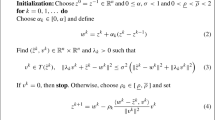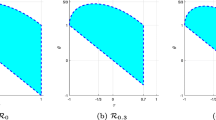Abstract
We derive a new approximate version of the alternating direction method of multipliers (ADMM) which uses a relative error criterion. The new version is somewhat restrictive and allows only one of the two subproblems to be minimized approximately, but nevertheless covers commonly encountered special cases. The derivation exploits the long-established relationship between the ADMM and both the proximal point algorithm (PPA) and Douglas–Rachford (DR) splitting for maximal monotone operators, along with a relative-error of the PPA due to Solodov and Svaiter. In the course of analysis, we also derive a version of DR splitting in which one operator may be evaluated approximately using a relative error criterion. We computationally evaluate our method on several classes of test problems and find that it significantly outperforms several alternatives on one problem class.

Similar content being viewed by others
References
Bauschke, H.H., Combettes, P.L.: Convex Analysis and Monotone Operator Theory in Hilbert Spaces. Springer, New York (2011)
Beck, A., Teboulle, M.: A fast iterative shrinkage-thresholding algorithm for linear inverse problems. SIAM J. Imaging Sci. 2(1), 183–202 (2009)
Bertsekas, D.P.: Convex analysis and optimization. Athena Scientific, Belmont, MA, USA (2003). With Angelia Nedić and Asuman E. Ozdaglar
Boley, D.: Local linear convergence of the alternating direction method of multipliers on quadratic or linear programs. SIAM J. Optim. 23(4), 2183–2207 (2013)
Boyd, S., Parikh, N., Chu, E., Peleato, B., Eckstein, J.: Distributed optimization and statistical learning via the alternating direction method of multipliers. Found. Trends Mach. Learn. 3(1), 1–122 (2011)
Dettling, M., Bühlmann, P.: Finding predictive gene groups from microarray data. J. Multivariate Anal. 90(1), 106–131 (2004)
Duarte, M.F., Davenport, M.A., Takbar, D., Laska, J.N., Sun, T., Kelly, K.F., Baraniuk, R.G.: Single-pixel imaging via compressive sampling: Building simpler, smaller, and less-expensive digital cameras. IEEE Sig. Proc. Mag. 25(2), 83–91 (2008)
Eckstein, J.: Splitting methods for monotone operators with applications to parallel optimization. Ph.D. thesis, Massachusetts Institute of Technology (1989)
Eckstein, J., Bertsekas, D.P.: On the Douglas-Rachford splitting method and the proximal point algorithm for maximal monotone operators. Math. Program. 55(3), 293–318 (1992)
Eckstein, J., Fukushima, M.: Some reformulations and applications of the alternating direction method of multipliers. In: Hager, W.W., Hearn, D.W., Pardalos, P.M. (eds.) Large Scale Optimization: State of the Art, pp. 119–138. Kluwer, Dordrecht (1994)
Eckstein, J., Silva, P.J.S.: A practical relative error criterion for augmented Lagrangians. Math. Program. 141(1–2), 319–348 (2013)
Eckstein, J., Yao, W.: Approximate versions of the alternating direction method of multipliers. Tech. Rep. 2016-01-5276, Optimization Online (2016)
Eckstein, J., Yao, W.: Approximate ADMM algorithms derived from Lagrangian splitting. Comput. Optim. Applic. (2017). Available online
Fan, R.E., Chen, P.H., Lin, C.J.: Working set selection using second order information for training support vector machines. J. Mach. Learn. Res. 6, 1889–1918 (2005)
Fleming, P.J., Wallace, J.J.: How not to lie with statistics: The correct way to summarize benchmark results. Commun. ACM 29(3), 218–221 (1986)
Fortin, M., Glowinski, R.: On decomposition-coordination methods using an augmented Lagrangian. In: Fortin, M., Glowinski, R. (eds.) Augmented Lagrangian Methods: Applications to the Numerical solution of Boundary-Value Problems, Studies in Mathematics and its Applications, vol. 15, pp. 97–146. North-Holland, Amsterdam (1983)
Franklin, J.: The elements of statistical learning: data mining, inference and prediction. Math. Intelligencer 27(2), 83–85 (2005)
Gabay, D.: Applications of the method of multipliers to variational inequalities. In: Fortin, M., Glowinski, R. (eds.) Augmented Lagrangian Methods: Applications to the Numerical Solution of Boundary-Value Problems, Studies in Mathematics and its Applications, vol. 15, pp. 299–331. North-Holland, Amsterdam (1983)
Guyon, I., Gunn, S., Ben-Hur, A., Dror, G.: Result analysis of the NIPS 2003 feature selection challenge. In: Saul, L., Weiss, Y., Bottou, L. (eds.) Advances in Neural Information Processing Systems 17, pp. 545–552. MIT Press, Cambridge, MA (2005)
Kogan, S., Levin, D., Routledge, B.R., Sagi, J.S., Smith, N.A.: Predicting risk from financial reports with regression. Proceedings of Human Language Technologies: The 2009 Annual Conference of the North American Chapter of the Association for Computational Linguistics. NAACL ’09, pp. 272–280. Association for Computational Linguistics, Stroudsburg, PA (2009)
Lawrence, J., Spingarn, J.E.: On fixed points of nonexpansive piecewise isometric mappings. Proc. London Math. Soc. 55(3), 605–624 (1987)
Liang, J., Fadili, J., Peyré, G.: Convergence rates with inexact non-expansive operators. Math. Program. 159(1–2), 403–434 (2016)
Lichman, M.: UCI machine learning repository (2013). http://archive.ics.uci.edu/ml
Lions, P.L., Mercier, B.: Splitting algorithms for the sum of two nonlinear operators. SIAM J. Numer. Anal. 16(6), 964–979 (1979)
Liu, D.C., Nocedal, J.: On the limited memory BFGS method for large scale optimization. Math. Program. 45(3), 503–528 (1989)
Ng, A.Y.: Feature selection, \(L_1\) vs. \(L_2\) regularization, and rotational invariance. In: Proceedings, Twenty-First International Conference on Machine Learning, ICML 2004, pp. 615–622 (2004)
Nocedal, J., Wright, S.J.: Numerical Optimization, 2nd edn. Springer, New York (2006)
Passty, G.B.: Ergodic convergence to a zero of the sum of monotone operators in Hilbert space. J. Math. Anal. Appl. 72(2), 383–390 (1979)
Rockafellar, R.T.: Convex Analysis. Princeton University Press, Princeton (1970)
Rockafellar, R.T.: Monotone operators and the proximal point algorithm. SIAM J. Control Optim. 14(5), 877–898 (1976)
Solodov, M.V., Svaiter, B.F.: A hybrid projection-proximal point algorithm. J. Convex Anal. 6(1), 59–70 (1999)
Solodov, M.V., Svaiter, B.F.: An inexact hybrid generalized proximal point algorithm and some new results on the theory of Bregman functions. Math. Oper. Res. 25(2), 214–230 (2000)
Tibshirani, R.: Regression shrinkage and selection via the lasso. J. Roy. Statist. Soc. Ser. B 58(1), 267–288 (1996)
Tseng, P.: Applications of a splitting algorithm to decomposition in convex programming and variational inequalities. SIAM J. Control Optim. 29(1), 119–138 (1991)
Yan, M., Yin, W.: Self equivalence of the alternating direction method of multipliers. In: Glowinski, R., Osher, S.J., Yin, W. (eds.) Splitting Methods in Communication, Imaging, Science, and Engineering. Springer, Cham, Switzerland (2016)
Author information
Authors and Affiliations
Corresponding author
Additional information
This work was funded in part by the National Science Foundation under Grants CCF-1115638 and CCF-1617617. The authors would also like to thank the anonymous referees for suggesting numerous corrections and enhancements to this paper.
Rights and permissions
About this article
Cite this article
Eckstein, J., Yao, W. Relative-error approximate versions of Douglas–Rachford splitting and special cases of the ADMM. Math. Program. 170, 417–444 (2018). https://doi.org/10.1007/s10107-017-1160-5
Received:
Accepted:
Published:
Issue Date:
DOI: https://doi.org/10.1007/s10107-017-1160-5




